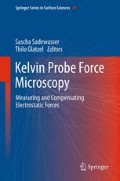Abstract
Kelvin probe force microscopy is a scanning probe microscopy technique providing the capability to image the local surface potential of a sample with high spatial resolution. It is based on the non-contact atomic force microscope and minimizes the electrostatic interaction between the scanning tip and the surface. The two main working modes are the amplitude modulation and the frequency modulation mode, in which the electrostatic force or the electrostatic force gradient are minimized by the application of a dc bias voltage, respectively. For metals and semiconductors, the contact potential difference is determined, which is related to the sample’s work function, while for insulators information about local charges is obtained. This chapter provides a brief introduction to non-contact atomic force microscopy and describes the details of the various Kelvin probe force microscopy techniques.
Access this chapter
Tax calculation will be finalised at checkout
Purchases are for personal use only
Notes
- 1.
In principle, the definition of the CPD could also be selected as \({V }_{\mathrm{CPD}} = ({\Phi }_{\mathrm{tip}} - {\Phi }_{\mathrm{sample}})/e\), which corresponds to − V CPD of (2.13). We selected the definition of (2.13) such that the changes in V CPD directly correspond to changes in the work function. Thus, images of V CPD represent the same contrast as images of the sample’s work function Φ sample, just with a constant absolute offset, which is equal to the work function of the tip. In the experimental realization this would correspond to a situation, where the voltage is applied to the sample and the tip is grounded (see Sect. 2.7).
References
D.W. Abraham, C. Williams, J. Slinkman, H.K. Wickramasinghe, J. Vac. Sci. Technol. B 9, 703 (1991)
T.R. Albrecht, P. Grütter, D. Horne, D. Rugar, J. Appl. Phys. 69, 668 (1991)
G. Binnig, H. Rohrer, Ch. Gerber, E. Weibel, Phys. Rev. Lett. 49, 57 (1982)
G. Binnig, C.F. Quate, Ch. Gerber, Phys. Rev. Lett. 56, 930 (1986)
H.-J. Butt, M. Jaschke, Nanotechnology 6, 1 (1995)
J. Colchero, A. Gil, A.M. Baró, Phys. Rev. B 64, 245403 (2001)
B.V. Derjaguin, V.M. Muller, Y.P. Toporov, J. Colloid. Interf. Sci. 53, 314 (1975)
R. Dianoux, F. Martins, F. Marchi, C. Alandi, F. Comin, J. Chevrier, Phys. Rev. B 68, 045403 (2003)
G.H. Enevoldsen, Th. Glatzel, M.C. Christensen, J.V. Lauritsen, F. Besenbacher, Phys. Rev. Lett. 100, 236104 (2008)
R. García, R. Pérez, Surf. Sci. Rep. 47, 197 (2002)
F.J. Giessibl, Phys. Rev. B 56, 16010 (1997)
Th. Glatzel, S. Sadewasser, M.Ch. Lux-Steiner, Appl. Sur. Sci. 210, 84 (2003)
T. Hochwitz, A.K. Henning, C. Levey, C. Daghlian, J. Slinkman, J. Vac. Sci. Technol. B 14, 457 (1996)
T. Hochwitz, A.K. Henning, C. Levey, C. Daghlian, J. Slinkman, J. Never, P. Kaszuba, R. Gluck, R. Wells, J. Pekarik, R. Finch, J. Vac. Sci. Technol. B 14, 440 (1996)
J.N. Israelachvili, Intermolecular and Surface Forces (Academic, London, 1992)
S. Kawai, H. Kawakatsu, Appl. Phys. Lett 89, 013108 (2006)
L. Kelvin, Phil. Mag. 46, 82 (1898)
A. Kikukawa, S. Hosaka, R. Imura, Appl. Phys. Lett. 66, 3510 (1995)
A. Kikukawa, S. Hosaka, R. Imura, Rev. Sci. Instrum. 67, 1463 (1996)
Y. Martin, C.C. Williams, H.K. Wickramasinghe, J. Appl. Phys. 61, 4723 (1987)
Y. Martin, D.W. Abraham, H.K. Wickramasinghe, Appl. Phys. Lett. 52, 1103 (1988)
F. Müller, A.-D. Müller, M. Hietschold, S. Kämmer, Meas. Sci. Technol. 9, 734 (1998)
M. Nonnenmacher, M.P. O’Boyle, H.K. Wickramasinghe, Appl. Phys. Lett. 58, 2921 (1991)
R. Pérez, M.C. Payne, I. Stich, K. Terukura, Phys. Rev. Lett. 78, 678 (1997)
P.A. Rosenthal, E.T. Yu, R.L. Pierson, P.J. Zampardi, J. Appl. Phys. 87, 1937 (1999)
Y. Rosenwaks, R. Shikler, Th. Glatzel, S. Sadewasser, Phys. Rev. B 70, 085320 (2004)
S. Sadewasser, M.Ch. Lux-Steiner, Phys. Rev. Lett. 91, 266101 (2003)
K. Sajewicz, F. Krok, J. Konior, Jpn. J. Appl. Phys. 49, 025201 (2010)
R. Shikler, T. Meoded, N. Fried, Y. Rosenwaks, Appl. Phys. Lett. 74, 2972 (1999)
R. Shikler, T. Meoded, N. Fried, B. Mishori, Y. Rosenwaks, J. Appl. Phys. 86, 107 (1999)
Ch. Sommerhalter, Dissertation, Freie Universität Berlin (1999)
Ch. Sommerhalter, Th.W. Matthes, Th. Glatzel, A. Jäger-Waldau, M.Ch. Lux-Steiner, Appl. Phys. Lett. 75, 286 (1999)
Ch. Sommerhalter, Th. Glatzel, Th.W. Matthes, A. Jäger-Waldau, M.Ch. Lux-Steiner, Appl. Surf. Sci. 157, 263 (2000)
J.M.R. Weaver, D.W. Abraham, J. Vac. Sci. Technol. B 9, 1559 (1991)
C.C. Williams, Annu. Rev. Mater. Sci. 29, 471 (1999)
M. Yan, G.H. Bernstein, Ultramicroscopy 106, 582 (2006)
U. Zerweck, Ch. Loppacher, T. Otto, S. Grafström, L.M. Eng, Phys. Rev. B 71, 125424 (2005)
L. Zitzler, S. Herminghaus, F. Mugele, Phys. Rev. B 66, 155436 (2002)
Author information
Authors and Affiliations
Corresponding author
Editor information
Editors and Affiliations
Rights and permissions
Copyright information
© 2012 Springer-Verlag Berlin Heidelberg
About this chapter
Cite this chapter
Sadewasser, S. (2012). Experimental Technique and Working Modes. In: Sadewasser, S., Glatzel, T. (eds) Kelvin Probe Force Microscopy. Springer Series in Surface Sciences, vol 48. Springer, Berlin, Heidelberg. https://doi.org/10.1007/978-3-642-22566-6_2
Download citation
DOI: https://doi.org/10.1007/978-3-642-22566-6_2
Published:
Publisher Name: Springer, Berlin, Heidelberg
Print ISBN: 978-3-642-22565-9
Online ISBN: 978-3-642-22566-6
eBook Packages: Chemistry and Materials ScienceChemistry and Material Science (R0)

